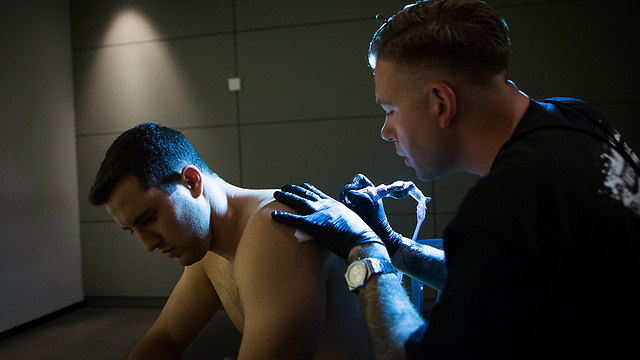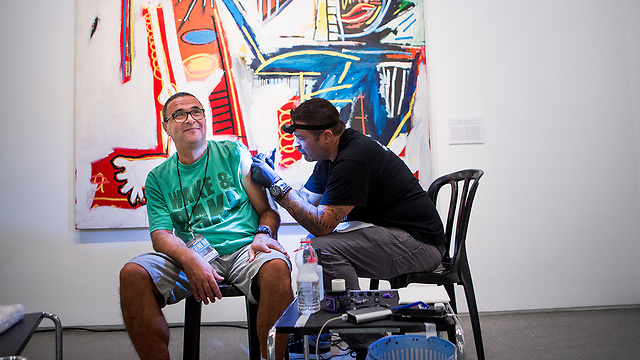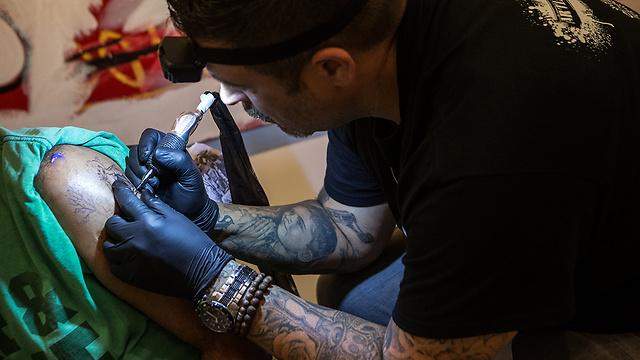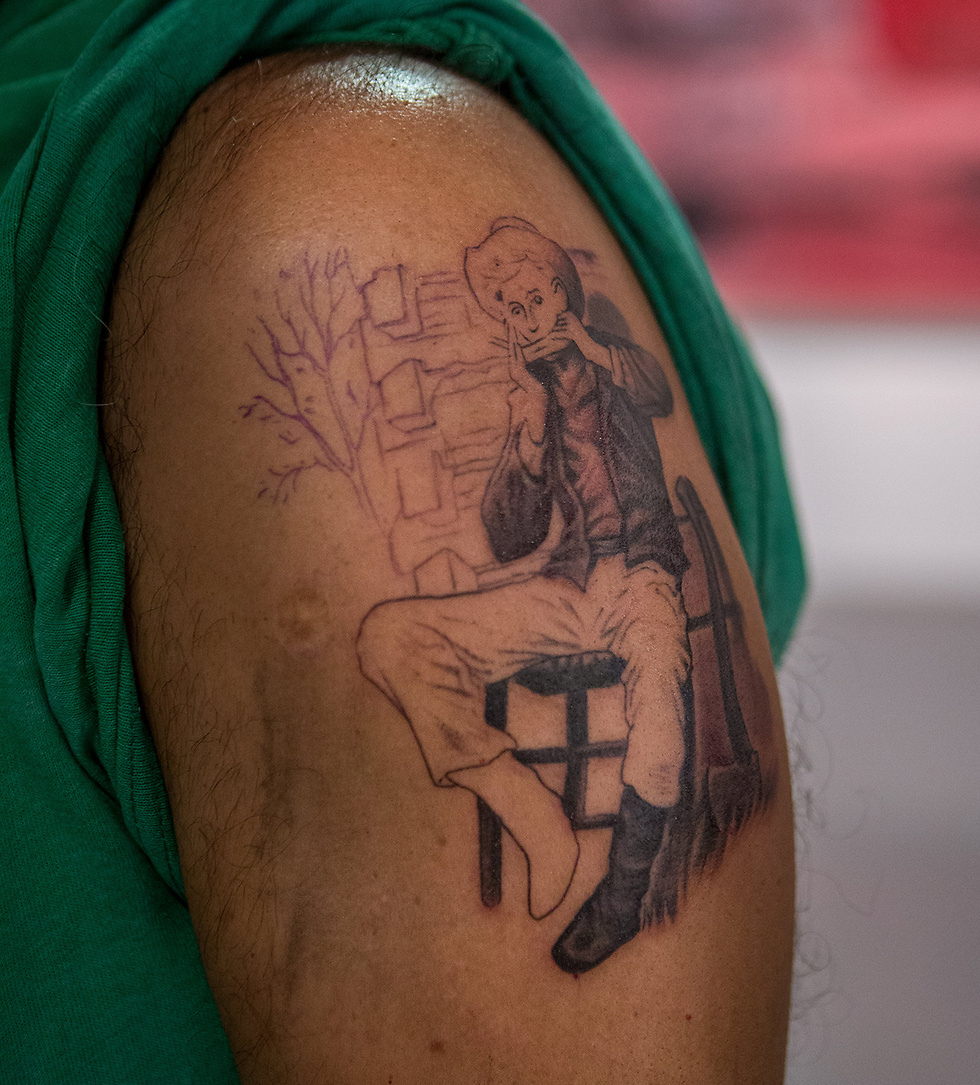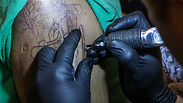
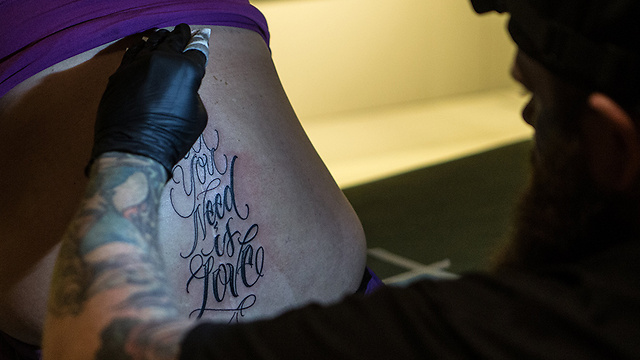
‘Healing Ink’: Tattoo artists cover terror victims’ scars
As part of a surprising collaboration between the Israel Museum and Artists4Israel organization, people injured in war, military service and terror attacks team up with international tattoo artists, who decorate their bodies as a way to help them recover from their physical and mental scars.
Ben Yosef is remarkably calm, considering the fact that she’s about to get on the tattoo bed. The location is the last place one would think of getting a tattoo at—the Israel Museum in Jerusalem. The project she is taking part in, Healing Ink, is a collaboration between the museum and the Artists4Israel organization. International tattoo artists, including three from Israel, meet with Israelis who were injured in war, terrorism and other forms of conflict and try to cover their scars—from the outside, at least.
“I’m tattooing the words ‘All You Need is Love,’” she explains. “The sights I saw basically dragged me into a sort of social isolation. I buried myself in work, I excluded my family and friends, I built so many walls around me. Today, at my grand age, I’ve reached the conclusion that I want my family and friends. I’ve invested so much in keeping everyone away, and now they’re afraid to come. So I’m tattooing it in a very noticeable way. It’s a call: People, love me. I’m cute! I have a lot of walls, but I’m cute.”
Each of the tattoo tables is situated in front of a different work of art in the museum. The location isn’t random. Each pair, the artist and the person getting the tattoo, chose where to place the alternative tattoo table together. Ben Yosef, for example, chose a lion sculpture.
Why get a tattoo here of all places, in the middle of the museum near a lion statue?
“I’m sitting here and getting a tattoo in front of my country’s history, a history which I physically fought for. I left parts of my body in the state.”
“This is my first tattoo,” says 24-year-old Ben Morag from the other side of the lion sculpture. “After everything I went through in the army with my injury, I’m not afraid it’ll hurt, but I’m still a bit concerned. I hope I don’t embarrass myself.”
Morag served in the Oketz canine special forces unit. During Operation Protective Edge, a structure they entered in Khan Younis collapsed on them. “I shielded the dog,” he recalls, “because that’s what they do for you, so your instinct is to do it for them too. I made sure that he would be evacuated first. The collapse dislocated my shoulder and broke my front teeth.”
He says he decided to come to the museum because “when you experience an injury, any kind of injury—it doesn’t have to be dramatic like an injury in Protective Edge—you eventually carry scars which you didn’t choose on your body and soul for the rest of your life. Here, you’re putting something on your body which you choose to carry for life.”
He situated the tattoo right under the place of the injury, in his left shoulder blade. The drawing is of a lion with a blurred face and sharp eyes.
“It’s an idea which may sound simple to many people, but it’s meaningful—always focusing on what you want. When I was wounded, I remained calm and focused. I made sure that the dog was removed first and I tried to walk on my own to see that I could. It’s something I still believe in: I didn’t sink into the injury, but remained focused on my rehabilitation process.”
‘I’m receiving a gift today’
Shai Maltabashi, 36, was wounded in a number of different incidents in Lebanon and Gaza and witnessed a deadly terror attack at a supermarket in Jerusalem’s Kiryat Yovel neighborhood in 2002.
“I hardly have any physical injuries in my body,” he says from a dark corner of the museum, near ancient Egyptian tombs. “My main injury is post trauma,” he explains, embraced by his partner, as an artist tattoos his left hand. “As a result of the events I experienced, there were emotions that I kept inside for years, but when they erupted—it was a powerful.
“Today I’m receiving a sort of gift,” he says. “I’m a divorced father with two amazing daughters. The bracelet on my hand was prepared by them so that I would think about them all the time. So I decided to tattoo their names, Liel and Hili, with the lotus plant I love so much. The flower is a sign of a new beginning. After the injury, I was always afraid of falling into flashbacks and the bad dreams that followed. Since the girls arrived, I’m a father before anything else. Besides, after the tattoo I’ll be able to take off the bracelet,” he adds, smiling.
Explaining his decision to get his tattoo near the Egyptian tombs, he says: “In Egyptian culture, they believed that there was an afterlife, that there was a path, so they would send them with gifts for the next round. I got another chance too. I got several chances. Everyone knows they’re going to die eventually, and reliving the same moment again and again and again in your dreams, that you’re about to die, is very powerful and very traumatic. This seemed like the best place for me to do it.”
Would you say the tattoo is an external expression of something internal?
“I think that a tattoo in general is something aimed at providing a concrete reminder of something you feel. I have no physical injuries, I haven’t lost a hand, I haven’t lost a leg, I don’t have a scar from a bullet that went in and out. My injury is internal, and unfortunately, many people suffering from post-trauma in Israel are completely transparent. You have to go through hell to prove that you’re carrying baggage.
“When you lose a hand or a leg, people see you. In my case, it’s something that’s hiding inside. But I intentionally avoided tattooing an image of a wounded soldier or something of the kind. I don’t need a reminder, because I have a daily reminder of that. So this tattoo is a reminder of the things I love in life.”
‘Giving love through ink’
“I heard about this project through the IDF Disabled Veterans Organization,” says Avi Antebi. “Every year on my birthday, for the past 15 years, my wife and I have been going to tattooed, and the minute I go in—I walk right out. When I told her I was registering for this project, I said: ‘I’m 49 years old. Who’ll take me seriously? And they did, and now I’m here and I have nowhere to run,” he says, half joking.
Antebi was wounded in 1986. He served in the Golani Brigade, and during a swearing-in ceremony at the Western Wall, terrorists threw three grenades at the soldiers. One of them hit him in the legs.
He is getting a tattoo on his arm, an image of a man sitting outdoors and playing music. “The tattoo relates to me, not to the injury. A man sitting on his own outside, with his music and serenity. Is there anything better?”
“The story of what Avi went through and his tattoo are a great way of therapy,” says tattoo artist Franco Vescovi. “He has a scar in his leg from the incident, and today we’re going to give him a wonderful work of art which he’ll be able to look at. He has a choice today—either to look at the scar or to look at the tattoo. And when he looks at the tattoo, it’ll make him happy.”
This isn’t exactly the clientele you are used to.
“There isn’t much terror in California. Here it’s a different kind of tragedy, so it’s a different kind of experience for me too. It’s also a challenge for me to be able to feel the energies of what Avi experienced. I got to give him the ability to turn his eyes away from his scar, give him something new to look at on his body.”
A Mike’s Place tattoo
The last pair looks as if it came out of a Hollywood film. The woman getting a tattoo is Shiri Mirvis, who was injured in the Mike’s Place attack in Tel Aviv in 2003. The tattoo artist is Wasim Razook, a Christian Arab from east Jerusalem. She chose to perpetuate the logo of the bar the attack took place in, around the scar she was left with.
“It was important for me to leave the scar,” Mirvis explains. “I don’t want to conceal it. My connection with Wasim was fate. I wasn’t even planning on getting a tattoo today, I was just escorting a friend.”
“I represent myself as a human being. I don’t care if a person is Jewish, Arab, Christian. There are people who’ll think that because I’m Arab I may be dangerous, and I want to be here and prove that it isn’t so. Not just to Israelis, but mainly to Arabs who are watching an Arab giving tattoos to Israelis who were in terror attacks, so it possibly says something about him as a person.
“We’re all human beings. Last year, I applied a tattoo on Kay Wilson, who was stabbed in a terror attack 13 times. Before I began tattooing her, I joked: ‘You know I’m about to stab you with the needle thousands of times?’ We laughed and it created a good connection between us. At home I was taught to love, and this is how I feel, like I’m giving love with the ink and it stays on for life.”















